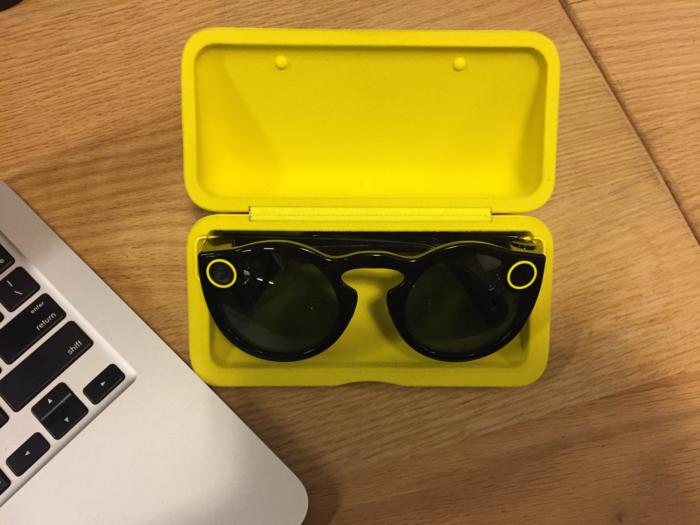Written by guest author Lindsay Boyajian, CMO at Augment
Snapchat has been acquiring companies and releasing augmented reality features, setting itself up to be an AR global leader.
When you think of augmented reality (AR), names like Microsoft Hololens, MagicLeap, Vuforia and Blippar come to mind. When you think of social media, you think of Instagram, Snap, Linkedin and Facebook. However, one of these social media players is an augmented reality company in disguise—Snap, Inc.
Snapchat, owned by Snap Inc., is one of the biggest AR companies today. Over the past few years, Snapchat has been rolling out more and more features to its ephemeral photo sharing app that are blurring the line between our physical and digital worlds. These features plus a string of acquisitions point to Snap’s ambitions beyond photo sharing.
Snapchat’s evolution
In July 2014, we saw Snapchat’s first move towards AR with geofilters. AR overlays digital assets on the real environment. With geofilters, users could now place location-based image tags on their photos.
In June 2015, Snapchat introduced branded geofilters, allowing brands to pay for custom geofilters to reach Snapchat’s coveted millennial audience. In other words, Snapchat began monetizing augmented reality ads. McDonald’s was the first company to launch a geofilter campaign, and today nearly all the major brands have followed suit. AR has become Snapchat’s secret moneymaker.
Geofilters were just the start. Later in 2015, Snapchat came out with lenses or facial filters. Lenses are filter overlays that augment your face. Snapchat acquired Looksery, a facial recognition startup, to power this feature. This represents one of Snapchat’s first acquisitions in the AR space (Hint: more to come).
In June 2016, Snap made a quiet acquisition of Seene, a computer vision startup that allows users to make 3D selfies from their mobile devices. Seene can scan and recreate 3D objects on-the-go, which has a number of different AR use cases.
In November 2016, Snapchat took lenses even further when it released a new feature called “world lenses.” World lenses allow users to apply an animation or effect to the environment. For instance, users can overlay falling hearts on the background of their photos.
Each iteration of lenses shifts Snapchat further into the realm of AR and hints at its larger ambition in AR.
Nothing points towards this more than Snapchat’s recent acquisition of AR startup Cimagine. Cimagine allows users to visualize products in the real world environment through their mobile devices. Snap’s interest is Cimagine’s 3D visualization technology that allows models to be placed and anchored in space without trackers or markers. With Cimagine’s technology, Snapchat will be able to further enhance the AR experience for users and brands by offering more life-like visualizations.
Is Snapchat becoming a hardware company?
This evolution was just the beginning. In November 2016, Snap Spectacles hit the market. Spectacles are a clear signal that Snap is thinking not only about AR content, but also hardware. Specs are Snapchat’s $130 sunglasses with a camera inside that take short videos for Snapchat. Specs use Bluetooth to seamlessly sync video content from the glasses to your Snapchat app.

This initial rollout of Specs is a market test for Snap: Will consumers adopt head-wearable tech? Consumers have been receptive to Snap’s brightly colored and quirky glasses. Thanks to a fun design and marketing, Specs have avoided the perception issue of Google Glass.
Snap glasses change how we interact with hardware. With Specs, you no longer have to take out a piece of hardware to capture a moment. I recently used Specs while hiking on vacation. I didn’t have to be bothered to pull out my iPhone to capture the scenery in cold weather. With a simple tap on my sunglasses, I could capture the moment through my eyes with ease. (See my video below.) The hardware became part of the experience. The product further blurs the line between technology and reality.
https://www.youtube.com/watch?v=QLabXnEPpHY
What’s next for Snapchat?
At the moment, Specs take only short videos, but in the future, lenses, filters and even more advanced AR capabilities can be incorporated. Specs can become an advanced AR headset by integrating the technology Snap has acquired over the last few years. Snap has proved it has the formula to spur customer adoption of head-mounted technology. Next up is integrating its content into the hardware.
With Snap’s IPO on the horizon, investors are already curious as to how Snap will continue its impressive rise. The company earned $404.5 million in revenue in 2016, up from $58.7 million in 2015. As we look at the history of the company, it is evident that Snap is betting on AR to drive future growth.
Snapchat may have started as an ephemeral photo sharing app popular among teens, but today the company is positioned to be a global leader in augmented reality.
A version of this article originally was published on Network World.
Disclaimer: We actively write about the themes in which we invest: artificial intelligence, robotics, virtual reality, and augmented reality. From time to time, we will write about companies that are in our portfolio. Content on this site including opinions on specific themes in technology, market estimates, and estimates and commentary regarding publicly traded or private companies is not intended for use in making investment decisions. We hold no obligation to update any of our projections. We express no warranties about any estimates or opinions we make.